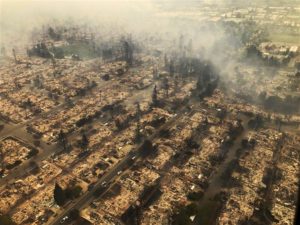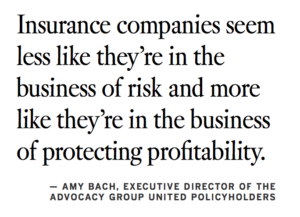Widespread fires burn through thousands of California homes year over year. This doesn’t only affect the homeowners and their families but also lays immense pressure on firefighters in these dry areas in addition to the struggles of insurance companies that insure these households and properties that are prone to blow up in flames.
The aftermath of recent Northern California wildfire. Source: NBC News
Considering the recent fires burning through Northern and Southern California, I am discussing the economic impact that this disaster-prone state has on insurance companies. As one of the driest states in the United States of America, it seems like insurance companies struggle as California officials don’t do much to mitigate these risks. There is not much of a boundary for homeowners to build on land that is so dry that the probability of a wildfire is high. It feels like these fires that happen on a yearly basis are not enough for someone to take a step in the direction for safer housing, which would result in insurance companies saving money, as well. While public resources are spent defending or salvaging what is left of those homes which shouldn’t have been built in the first place, insurance companies must defend themselves or they are at risk for driving themselves out of business.
As California residents sift through the ash and hope to rebuild, funds may be insufficient, as insurance companies don’t need to cover one homeowner’s lost property, but the entire community (if not more). According to a Forbes article discussing insurance and loss of use for the recent victims of the Woolsey and Camp Fire in Los Angeles and Ventura County, “What is often overlooked is loss of use coverage. How long will it take to repair or rebuild?” (Gorman). Loss of use, or living expenses during the duration of the recovery process, usually covers living expenses and rental value. Although, not all insurance plans have this, and when a fire causes destruction, Californians may be surprised when their insurance companies don’t fully cover these temporary living costs. Homeowners in these high-risk areas must understand that in cases of natural disasters, they may be left with a much lighter wallet than expected.
According to a Los Angeles Times article discussing fleeing insurers, insurance companies in high-risk areas for natural disasters are no longer agreeing to insure homes. For example, a couple living in Lake County in Northern California is denied insurance. In the area which the couple resides, “50% of the land has been burned by fires in the past several years” (Newberry). With an already expensive premium of $2,100, their rate had skyrocketed to $5,800 in only two years (Newberry). The increase in California wildfires leads to more fleeing insurers. What insurers have continued to do in California is to inflate the price of insurance in high-risk areas to veer builders away from this land, and make home buyers think twice before buying a property with a likelihood to catch fire.
The Los Angeles Times article also provides statistics on the California Department of Insurance: This department acknowledges that the trend of inflating insurance prices is a rational and fair response on the part of the insurance companies. In 2017 alone, they “received nearly $12 billion in claims from wildfires that destroyed more than 32,000 homes. It makes sense that companies will write fewer – if any – policies in areas where they predict losses will outweigh what they can recoup through premiums.
What’s next? Legislators must act to protect home buyers and homeowners who have made efforts to reduce wildfire risk.
The Nature of Wildfires
The risks of more intense wildfires ahead increase due to climate change and the expansion of urban living near forest areas. The geography in California, especially near the coast which is a popular place to live is mountainous and dry. There are dense populations living in California locations which have a high risk of wildfire around them. According to Lloyd’s report, Wildfire: A Burning Issue for Insurers, global warming “is expected to increase average global temperatures and, in some regions, drought frequency and severity will increase” (Doerr). This could lead to a longer season of more frequent fires.
The Lloyd’s report, Wildfire: A Burning Issue for Insurers, also discusses the socio-economic and land use changes in society: “Population growth at the fringe of urban and wildland areas in North America has raised the likelihood of wildfire ignitions, whereas rural depopulation and abandonment of traditional agriculture has led to vegetation build-up, increasing the risk of severe fires” (Doerr).
Not only is it important to understand the weather and living trends of people to analyze potential risk of fires, but sometimes fires start from actions out of our control. Maybe lightning strikes a tree in the middle of a desert, or someone forgot to stop their cigarette from burning. In densely populated areas, accidental human ignitions are a common cause to wildfires. These wildfires pose a threat to lives and infrastructure; massive losses can occur, which will affect insurance companies.
Wildfire Risk
Recently, the insurance industry has taken hit after hit with regards to covering damage due to California wildfires. The threat of wildfires extends beyond the months of summer, but even when the Santa Ana winds blow in the fall.
According to Risk and Insurance’s article about living with wildfire risk, “The evolution of wildfire risks creates challenges for the insurance industry, especially as events occur more often in areas with significant insurance penetration” (Amaral). Therefore, the expected increase in wildfires in urban areas will have some implications for the insurance industry.
Risk and Insurance further discusses the risk management which insurance companies undergo to protect their companies. According to Kevin Van Leer, product manager at RMS (Risk Management Solutions), “‘From a (risk) modeling point of view, probabilistic methods can enable insurers and reinsurers to better manage their accumulations of exposure, particularly in the wildland-urban interface.’ But several challenges remain on proper aggregation of exposures” (Amaral). Factors like the amount of rainfall in the summer and snow in the winter must be considered to understand and mitigate risk. The unpredictability of weather trends leaves insurance companies walking on eggshells deciding which areas to choose are the most prone to yet another fire.
Mitigating Risk
For less houses to be burned down and more healthy and happy humans to live in society, a joint effort between public agencies and private owners is necessary. According to Lloyd’s Wildfire: A Burning Issue for Insurers, “Different public policies can increase the commitment of private landowners, such as subsidizing private spending on fuel treatments, enacting legislation that marries insurance availability and premiums to risk mitigation behavior and providing education about wildfire risk and mitigation. For instance, laws exist in some US states that require fuel treatments on private land” (Doerr). But, why don’t laws exist in all US states, especially the states more prone to fires? Although the government and insurance agencies have taken steps to fix the problem, there is still a long way to go.
Inflated premiums could prove effective, as it would drive away the lower income homeowners that are unlikely to pay a high insurance premium each month. Although, the wildfire risk affecting more valuable homes still poses an issue for insurance companies even if the homeowners can afford it. In a case when the home burns down, the insurance companies are still accountable for paying the losses. Rather than raising premiums in high-risk areas, insurance companies should minimize areas available for homebuilding.
Introducing zoning regulations prohibiting or limiting building in high wildfire risk areas would be a significant advancement in wildfire mitigation.
Often, homeowner’s and insurance agencies’ preferences differ. Neighborhoods form as many homeowners adore the natural aesthetic living in wildfire-prone areas; therefore, effective mitigation should be enforced on a neighborhood level. Insurance companies must zone these high-risk areas by either restricting all homeowners to build property. The other option is restricting none, but inflating the insurance premiums higher than their 3 story roofs. Insurance companies will need to offer similar mitigation efforts for adjacent properties to maintain homeowner trust and commitment.
The “new normal” which insurance companies face is almost double the costs of damages from the previous year. Based on Insurance Journal, an analysis from Moody’s breaks down the losses of the recent fires in Northern and Southern California. The losses in California generated last year were around $12.5 billion, while these recent fires in the past few weeks alone have predicted losses of $6.8 billion— and fire season is not finished just yet (Jergler). With years of wildfire history showing fires worsen year over year, it is shocking to see neither insurance companies or government agencies taking more action to minimize the risk.
What the Future Holds
Milliman, a management consulting published an article written by consulting actuaries David Chernick and Paul Anderson, about how insurance companies react to California wildfires. While California real estate continues to rise, “the amount of coverage selected by policyholders had not kept pace with the increase in home values, especially on policies that were 10 or more years old” (Anderson).
Paul Anderson is asked how wildfires will affect insurers’ future decisions on where to write policies. After a major wildfire, insurance companies will “look to re-underwrite their books to ensure that their exposure and their risk are appropriately spread out in these wildfire-prone areas” (Anderson). Chernick adds that companies should not write insurance policies for an entire area, as a natural disaster can spike the losses if insurance companies write policies for all houses in a concentrated area (Chernick).
Getting insurance is becoming harder as companies reject to insure houses just close enough to the woodlands that a spark of fire could burn up an entire city. There are many of those houses still standing in California. In an article explaining the effect of wildfires on Insurance companies in California published by the Insurance Journal, author Sarah Skidmore Sell discusses that it is harder for in-state residents to find and hold on to insurance (Sell).
“We are not at a crisis point yet, but you can see where the trends are going,” Insurance Commissioner of California, David Jones, stated in an interview (Sell). Jones’ expectations for the future of insurance companies is to “opt not to renew policies or to simply stop writing homeowners policies in areas with the highest fire risk” (Sell). Rate increases and reclassifications of fire-prone areas are also expected.
As claims continue to settle and policyholders and insurance companies undergo huge losses during times of natural disaster, it is shocking that we haven’t seen any necessary corrections in the insurance industry.
Rather than targeting the main issue that has led to the most disastrous fires of all time—climate change—insurance companies are canceling policies, boosting their prices and crossing their fingers that they get lucky enough to insure houses that don’t burn down.
How Insurance Companies Should Protect Themselves
According to the Union of Concerned Scientists, “the effects of global warming on temperature, precipitation levels, and soil moisture are turning many of our forests into kindling during wildfire season” (Is Global Warming Fueling..). The dry and hot areas in California are getting drier and hotter. This article on global warming impacts proves that global warming is a pressing issue that insurers must face: In the western United States, wildfires have been “increasing in frequency and duration since the mid-1980s. Between 1986 and 2003, wildfires occurred nearly four times as often, burned more than six times the land area, and lasted almost five times as long when compared to the period between 1970 and 1986” (Is Global Warming Fueling..).
Mike Scott, a contributor to Forbes who writes about the intersection of the environment and business, questions why insurance companies are not investing in a low-carbon economy. “The impacts of climate-related risks are a growing reality for the insurance sector. This reality has key implications for that sector’s valuation,” the report adds. “Weather-related financial losses, regulatory and technological changes, liability risks, and health impacts related to climate change have implications for the business operations, underwriting, and financial reserving of insurance companies.”Yet, the insurance industry is not aligning itself with initiatives to improve the issues that are causing the insurance companies to bury themselves in their own grave.
Works Cited:
Amaral, Rodrigo. “Living With Wildfire Risk.” Risk & Insurance, 12 Sept. 2017, riskandinsurance.com/living-wildfire-risk/.
Anderson, Paul, and David Chernick. “California Wildfires: Implications for Insurers and Policyholders.” Milliman, 2 Nov. 2007, www.healthcarefinancenews.com/news/transitional-policies-risk-corridor-tweaks-bring-new-market-implications.
Gorman, Megan. “What California Wildfire Victims Should Know About Insurance And Loss Of Use.” Forbes, Forbes Magazine, 18 Nov. 2018, www.forbes.com/sites/megangorman/2018/11/13/what-california-wildfire-victims-should-know-about-insurance-and-loss-of-use/#19d68f4e5423.
“Is Global Warming Fueling Increased Wildfire Risks?” Union of Concerned Scientists, 24 July 2018, www.ucsusa.org/global-warming/science-and-impacts/impacts/global-warming-and-wildfire.html#.XAdAky2ZOu4.
Jergler, Don. “How Insurance Industry Might React to ‘New Normal’ of California’s Historic Wildfires.” Insurance Journal, 14 Nov. 2018, www.insurancejournal.com/news/west/2018/11/13/507414.htm.
Johnson, Alex, et al. “ Northern California Wildfires Claim at Least 15 Lives as More Than 100K Acres Burn.” NBCNews.com, NBCUniversal News Group, 10 Oct. 2017, www.nbcnews.com/storyline/western-wildfires/one-killed-major-wildfires-ignite-overnight-across-northern-california-n809206.
Newberry, Laura. “As California Fire Disasters Worsen, Insurers Are Pulling out and Stranding Homeowners.” Los Angeles Times, Los Angeles Times, 31 Aug. 2018, www.latimes.com/local/lanow/la-me-ln-wildfire-homeowners-insurance-20180830-story.html.
Sell, Sarah Skidmore. “Fires May Make It Harder for Homeowners to Get Insurance in California.” Insurance Journal, 14 Aug. 2018, www.insurancejournal.com/news/west/2018/08/14/497977.htm.



